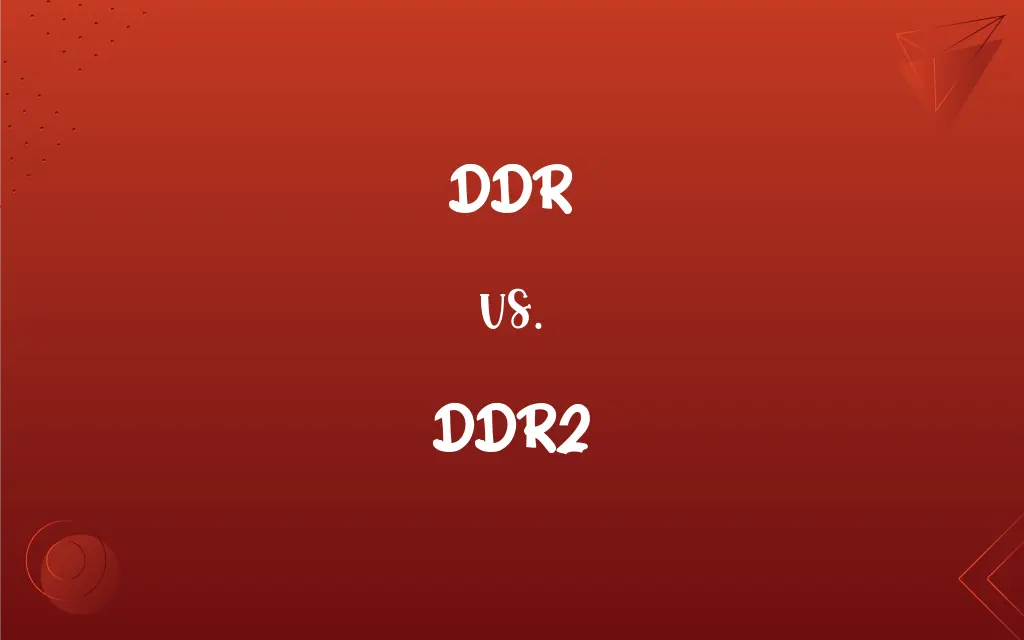DDR vs. DDR2: What's the Difference?
Edited by Aimie Carlson || By Janet White || Published on March 25, 2024
DDR (Double Data Rate) and DDR2 are types of RAM, with DDR2 being the successor of DDR, offering higher speeds, lower power consumption, and improved bandwidth.

Key Differences
DDR (Double Data Rate) RAM is a type of memory technology used in computers and electronic devices to store temporary data, enhancing the system's performance by allowing data transfers on both the rising and falling edges of the clock signal. DDR2 RAM is the second generation of DDR memory, building on the original DDR technology with several significant improvements that enhance the overall system performance and efficiency.
DDR RAM operates at a lower voltage and clock speed compared to DDR2, which means that while DDR RAM consumes more power, it runs at slower speeds. DDR2, on the other hand, was designed to use less power and achieve higher clock speeds, resulting in faster data transfer rates and better performance for computing tasks. This makes DDR2 a more efficient choice for newer computing systems.
One of the key differences between DDR and DDR2 RAM is in their design and operation. DDR2 introduces a new feature called "On-Die Termination" (ODT), which helps to prevent signal reflections and improve signal integrity, allowing for higher speeds. Additionally, DDR2 uses a different signaling technique that reduces electrical load on the memory controller, enabling more memory modules to be used.
The physical appearance of DDR and DDR2 modules is also different, with DDR2 having a different notch position on the connector to prevent it from being installed in a DDR slot, ensuring compatibility with the appropriate motherboard. This physical distinction helps users and technicians avoid potential damage or compatibility issues when upgrading or replacing memory modules.
DDR RAM laid the groundwork for modern RAM technologies by doubling the data rate compared to its predecessor, DDR2 took these advancements further by optimizing power consumption, increasing speed, and improving overall efficiency. As technology progressed, DDR2 eventually became the standard in many computer systems before being succeeded by later generations like DDR3 and DDR4.
ADVERTISEMENT
Comparison Chart
Speed
Lower speeds due to higher operating voltages.
Higher speeds enabled by improved technology.
Power Consumption
Higher due to older technology.
Lower due to more efficient power management.
Voltage
Operates at 2.5V.
Operates at 1.8V, reducing power needs.
Data Rate
Offers up to 400MHz (DDR-400).
Provides higher data rates, up to 800MHz (DDR2-800).
Physical Layout
Notch positioned differently than DDR2.
Notch positioned to prevent incorrect installation in DDR slots.
ADVERTISEMENT
DDR and DDR2 Definitions
DDR
DDR is a type of RAM that transfers data twice per clock cycle.
My old computer uses DDR RAM to handle its memory tasks.
DDR2
DDR2 modules are designed with a notch to prevent installation in incompatible DDR slots.
The notch in the DDR2 stick ensured I didn't insert it into a DDR slot by mistake.
DDR
DDR is a crucial component in older computer systems for temporary data storage.
I checked the motherboard compatibility before buying DDR memory.
DDR2
DDR2 is the improved version of DDR RAM, offering higher speeds and efficiency.
My new laptop is equipped with DDR2 RAM for better performance.
DDR
DDR consumes more power compared to newer memory types like DDR2.
Despite its higher power usage, DDR was pivotal in early 2000s computing.
DDR2
DDR2 uses lower voltage, making it more energy-efficient than its predecessor.
The lower voltage of DDR2 RAM helps extend my computer's battery life.
DDR
DDR enhances computer performance by increasing data transfer rates.
Upgrading to DDR improved my system's multitasking capabilities.
DDR2
DDR2 provides improved bandwidth for enhanced computing tasks.
DDR2's increased bandwidth allows for smoother video playback and gaming.
DDR
DDR stands for Double Data Rate, indicating its ability to double the data transfer.
DDR technology was a significant leap forward in memory efficiency.
DDR2
DDR2 introduced On-Die Termination to reduce signal noise and improve reliability.
The ODT feature in DDR2 RAM helps in maintaining system stability.
FAQs
Can DDR2 RAM be used in a DDR slot?
No, DDR2 RAM cannot be used in a DDR slot due to differences in voltage, pin count, and notch positioning.
What voltage does DDR operate at?
DDR operates at 2.5V.
What does DDR stand for?
DDR stands for Double Data Rate, a technology that transfers data twice per clock cycle.
What is the maximum data rate for DDR RAM?
The maximum data rate for DDR RAM is 400MHz (DDR-400).
Can I replace DDR RAM with DDR2 in my old computer?
No, DDR and DDR2 are not interchangeable due to differences in electrical and physical specifications.
What is On-Die Termination in DDR2?
On-Die Termination (ODT) in DDR2 helps to prevent signal reflections and improve signal integrity for higher speeds.
What is the main improvement of DDR2 over DDR?
DDR2 offers higher speeds, lower power consumption, and improved bandwidth compared to DDR.
Is DDR2 compatible with DDR3 slots?
No, DDR2 is not compatible with DDR3 slots due to different key notches and electrical specifications.
How does DDR2 reduce power consumption?
DDR2 reduces power consumption by operating at a lower voltage of 1.8V.
Can DDR and DDR2 be used together?
No, DDR and DDR2 cannot be used together due to their different specifications and motherboard compatibility.
Are there any disadvantages to DDR2 compared to DDR3?
While DDR2 was an improvement over DDR, DDR3 offers even higher speeds and greater efficiency.
What is the impact of DDR2's lower voltage on laptop battery life?
DDR2's lower voltage can lead to longer battery life in laptops by reducing overall power consumption.
What's the significance of the notch in DDR2 modules?
The notch in DDR2 modules prevents them from being installed in incompatible DDR slots.
Why did DDR2 become more popular than DDR?
DDR2 became more popular due to its superior performance, lower power consumption, and higher data transfer rates.
How do I know if my system supports DDR or DDR2?
Check your system's motherboard specifications or manual to determine if it supports DDR or DDR2.
How does DDR2 improve system stability?
DDR2 improves system stability through features like On-Die Termination and lower voltage operation.
What applications benefit from DDR2's higher speeds?
Applications such as gaming, video editing, and complex computational tasks benefit from DDR2's higher speeds.
What are the benefits of DDR2's improved bandwidth?
Improved bandwidth in DDR2 enhances system performance by allowing faster data transfer rates.
What is the highest speed available for DDR2 RAM?
The highest speed available for DDR2 RAM is 800MHz (DDR2-800).
Can I upgrade from DDR to DDR2 to improve my computer's performance?
You cannot directly upgrade from DDR to DDR2 without ensuring that your motherboard supports DDR2 RAM.
About Author
Written by
Janet WhiteJanet White has been an esteemed writer and blogger for Difference Wiki. Holding a Master's degree in Science and Medical Journalism from the prestigious Boston University, she has consistently demonstrated her expertise and passion for her field. When she's not immersed in her work, Janet relishes her time exercising, delving into a good book, and cherishing moments with friends and family.
Edited by
Aimie CarlsonAimie Carlson, holding a master's degree in English literature, is a fervent English language enthusiast. She lends her writing talents to Difference Wiki, a prominent website that specializes in comparisons, offering readers insightful analyses that both captivate and inform.







































































